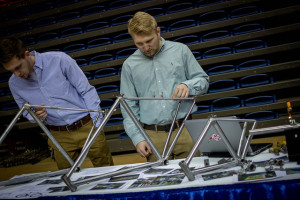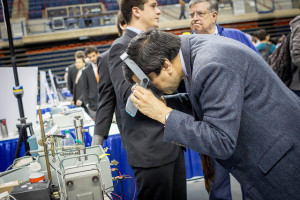Senior Design Day Is Coming
May 1 is annual Senior Design Day, when more than 160 student teams will set up their engineering projects at the Gampel Pavilion and present them from 1 pm to 4 pm.
In the one or two-semester Senior Design experience, senior students are mentored by faculty and industry engineers as they work to solve real-world engineering problems, typically for company sponsors. Students learn about the principles of design, how ethics affect engineering decisions, how professionals communicate ideas and the day-to-day implications of  intellectual property. Judges evaluate projects and cash prizes are awarded for excellence to top performers.
intellectual property. Judges evaluate projects and cash prizes are awarded for excellence to top performers.
Exhibition guides will be available to visitors.
Students begin by researching the problem, brainstorming a range of solutions, and traveling to the sponsor company site to learn more about the company and the project. As their projects take form, student teams maintain contact with their industrial and faculty mentors, hold meetings, write formal documentation, and make presentations on their work. Across the project period, the teams synthesize design know-how, judgment, technical skills, analysis, creativity and innovation to design, optimize and manufacture a prototype model, or to perform product simulations.
The event always brings a good turnout, and is particularly popular among alumni (the engineering alumni welcome desk will be located in the southeast corner on the exhibition floor – stop by!) . Dr. Lynwood Crary (B.S, M.S., Ph.D. Mechanical Engineering, ’89, ‘92, ’04) shared his personal reasons for attending the past two years.
“With at least one potential future UConn engineering student amongst my 13-year-old triplet children, we made our visit to Senior Design Day as a family affair, taking advantage of this great opportunity to expose them to the types of projects investigated by the various engineering disciplines – all under one (very large) roof,” he said.
Engineering students gain invaluable experience and insight about the types of real problems facing industry. In turn, sponsors benefit from having smart, dedicated and creative students tackling genuine design challenges. Many companies consider this process a powerful recruiting vehicle for future employees.
For more information go to the Senior Design website: http://seniordesign.engr.uconn.edu/
This year’s event has more than 50 sponsors, including US Department of Veterans Affairs, United Illuminating, GE and Covidien.
To take a look at some past Senior Design projects, watch this video!
 vice to help disabled people to stand, was inspired by a handwritten note from a desperate mother.
vice to help disabled people to stand, was inspired by a handwritten note from a desperate mother.
 their way through the campus parking lots a little more easily, and get to class on time.
their way through the campus parking lots a little more easily, and get to class on time.